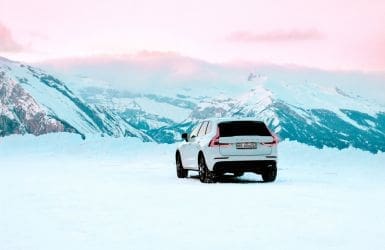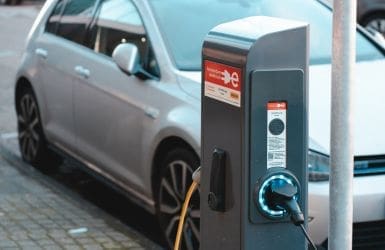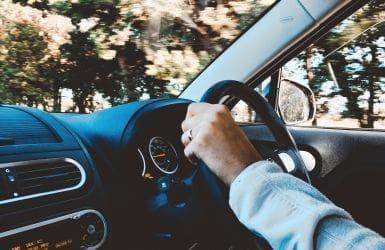New registration certificate as of 1-1-2014
From January 1, 2014, there will be a new registration certificate in the Netherlands. The paper registration certificate (part IA, IB and part II) will then be replaced by a credit card-sized registration certificate (the registration card) and a registration code. With the advent of the new single-volume registration certificate, there will also be significant changes to the vehicle registration process and the registration of vehicles. The owner/holder of a vehicle does not have to do anything themselves to obtain a new credit card-sized registration certificate, but will receive it when purchasing a new or used vehicle. If you want to switch to the new registration certificate earlier, you can apply for a replacement registration certificate through the website of the National Road Administration (RDW). The owner/holder of the vehicle will then receive by mail the new registration card with the corresponding registration code. After receiving these documents, the paper copy can be destroyed, it is then no longer valid.
Within 5 years everyone will have a new license plate?
It is expected that within 5 years all paper registration certificates will be replaced by the new registration certificate. By the way, owners of vintage cars may keep the paper/linen document and will receive a registration card and code next to it, which they will need during formal actions.
The registration card and the registration code will apply to all registered vehicles starting in 2014. However, special license plates will retain the paper registration certificate. Vehicles of, for example, the Royal House, diplomats and Defense, as well as exceptional transport, border traffic, transit license plates, temporary license plates and dealer license plates will retain the paper version.
Registration code is going to be important with the new registration certificate
The current Transfer Certificate (Part II or Copy Part III) will be abolished and replaced by the 9-digit registration code. You will need this for such registration processes as transferring the vehicle to another owner's name, applying for or lifting a license plate suspension at the registration desk, and exporting or scrapping the vehicle.
The registration code is issued in 2 parts and can only be used once. Once the code has been used, the owner/holder will be issued a new code. Others than the owner/holder are not authorized to use the entire code.
The first 4 digits of the registration code the new owner/holder receives after the registration at the license plate counter or at an RDW approved institution. The RDW processes this ascription the same working day and then also sends the registration card and the second part of the registration code (5 digits), so that the owner/holder receives it the next delivery day. With a (costly) rush application, it is possible to receive the registration card and the second half of the registration code the same day.
Duty to show registration certificate?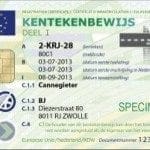
Have you had the license plate transferred to your name (transfer) but have not yet received the registration card? Then you may drive without a license plate until 14 days after the transfer. When driving abroad, the obligation to show the card remains in force.
What is a license plate counter and where are they located?
The license plate counter is a place where individuals and companies can have their vehicles registered and/or apply for, extend or lift a suspension.
Currently, the license plate counters are the inspection stations of the RDW, the RDW counters in Veendam and Zoetermeer, and authorized branches of PostNL.
In time, there should be more license plate counters nationwide, and with the central issuance of the license plate by the RDW in 2014, other agencies may also be eligible to become RDW license plate counters. The RDW regulates the recognition of these counters.
In the future, there should also be a digital license plate counter. This would further simplify and speed up the transfer process. However, this will only be possible once it can be verified with certainty that the person wishing to transfer the vehicle is actually the owner/holder. Unfortunately, with the current DigiD, this cannot yet be sufficiently guaranteed.
How does the license plate process work?
First registration of a new car
The buyer identifies himself at the dealer with a valid identification document. The dealer then puts the vehicle's registration number in the buyer's name and provides him with a form (called the "registration report"). This registration report contains the registration number and the first half (4 digits) of the registration code. This registration code is needed when the vehicle is sold and should therefore be kept properly.
Once in possession of the registration report, the customer can take the purchased vehicle. At that time, there is no registration certificate. However, this does not pose a risk, as the police can see online in the vehicle registration register when the customer is stopped that the car has been transferred and is in the customer's name.
The ascription by the dealer will be processed by the RDW on the same day. The registration certificate (the registration card) will be created on the same working day and, together with the second half (5 digits) of the registration code, sent directly by mail to the customer, who will receive the documents on the next delivery day. With the receipt of these pieces, the customer has everything complete; the registration card and the full 9-digit registration code. It is important to keep the registration card and the registration code separate.
Front of new registration certificate
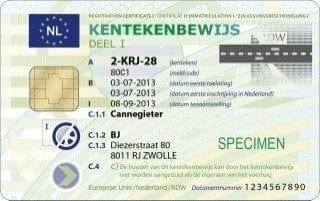
Back of new registration certificate
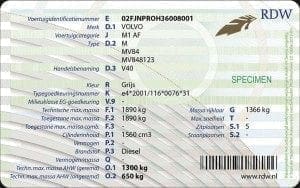
Changing owners
The owner of the vehicle hands the buyer the registration card and the registration code. With this, the buyer can go to a registration desk (findable via the RDW site) to have the car registered.
The new owner must identify himself at the registration desk and present the registration card and the registration code.
Once the license plate counter has approved and entered all the data, the registration card is cut in the presence of the new owner and the registration code expires.
The new owner then receives the first half of a new registration code as well as a release certificate intended for the previous owner (the selling party). Once the old owner is in possession of the indemnification certificate, the key transfer can take place. That same day, the registration is processed by the RDW and the new registration card and the second half of the new registration code are sent to the new owner of the vehicle, who receives the pieces the next delivery day. With the receipt of these pieces, the new owner now has everything complete; the registration card and the full 9-digit registration code. It is important to keep the registration card and the registration code separate.
The old owner has the indemnification certificate, is thus indemnified and no longer runs any risk regarding the sold car. However, it is important that the indemnification certificate is kept properly.
Suspending and de-suspending a license plate
If the car is not used for a longer period of time, for example due to a long stay abroad, the license plate can be suspended. This removes the obligations regarding the MOT, road tax and insurance (the insurance policy must still be suspended separately). Once the license plate is suspended, the car may no longer be on public roads, and it must be parked on private property (for example, in the driveway or garage) or stored in a garage.
Suspension and de-suspension of a license plate can easily be done online via the RDW site, by entering the license plate and personal DigiD code and making an electronic payment. Suspension and de-suspension can also be done at the license plate counter if desired.
Suspend online via the RDW site
The owner/holder of the vehicle can use DigiD to log in via Online Vehicle Suspension on the RDW website. Then the license plate number and the report code must be entered and until which date the license plate is to be suspended. After paying via iDEAL, the vehicle is immediately suspended and it is now also stated in the vehicle registration register that the vehicle has been suspended. Unlike before, no new documents are created. The customer should therefore keep the existing registration card carefully, as it will be valid again as soon as the vehicle goes/is taken out of suspension. The report containing the end date of the vehicle's suspension can be printed and should be kept. The registration code is not used for this operation and therefore remains valid.
Suspend through the license plate counter
At the registration desk, the registration certificate and the registration code must be handed over. The registration register will then show the date until which the vehicle has been suspended. Unlike before, no new documents are created. The customer should keep the existing vehicle registration card well, as it will be valid again once the vehicle goes/is taken out of suspension.
The owner/holder will receive a report from the registration desk containing the end date of the suspension of the vehicle, as well as the first 4 digits of the new registration code. The second part of the new registration code is sent by the RDW by letter to the owner/holder.
Extension of suspension
Extending the suspension is done in the same way as applying for the (first) suspension.
Termination of suspension (debarkation).
The suspension ends automatically at the end of the period specified by the owner/holder. The suspension is then also terminated in the vehicle registration register. The old vehicle registration card is automatically valid again after the end of the suspension period. If the suspension was applied for while the vehicle still had a paper license plate, then the owner/holder will receive a license plate card and registration code after the expiration of the suspension period. The paper document is then no longer valid.
If the owner/holder wishes to terminate the suspension before the specified de-suspension date, this can be done through the RDW website or through the registration desk. Through the RDW website, this can be done in the same way as suspending. At the license plate counter, the owner/holder uses the full registration code. He then receives a transaction report containing the date and time of the de-suspension and the first 4 digits of a new registration code. The RDW then sends the second part of the registration code by letter.
Once the vehicle is de-suspended, the car may be allowed back on the road with the existing registration card.
Importing a vehicle into the Netherlands
The buyer must take the vehicle to an RDW inspection station to verify and establish the vehicle's identity. Obligations imposed by Tax Authorities must also be met at that time. At inspection stations, the prospective owner/holder can have name, address and identification information recorded in advance while waiting for the vehicle to be assessed. If the application for the license plate is approved, the identification data can be used for the registration of the imported vehicle.
If all obligations are met, the RDW sends a new registration card to the registered owner/holder as well as the registration code and the registered data. The new owner/holder must then have their own license plates made at an authorized plate factory upon presentation of the license card.
When a vehicle has to be transported from abroad to the Netherlands, the vehicle needs a valid third-party insurance. This temporary car insurance can be taken out with us. You will then get a 15-day WA insurance from € 109,00.

Exporting a vehicle abroad
The foreign buyer receives the registration card and the registration code as well as both registration plates. With these he goes to an RDW accreditation holder authorized to provide "export services" or to an RDW desk. There he receives the indemnification certificate for the previous owner and a paper registration certificate part II, which together with the registration card is needed for re-registering the vehicle abroad.
At that time, the registration code is no longer valid, and the yellow license plates are destroyed. With the registration card, the registration certificate part II and the white registration plates (with the existing license plate), the new owner may drive the car to the border himself (provided the vehicle has a valid MOT). In this way, the vehicle disappears from Dutch roads and from Dutch administration. The vehicle receives the status 'export' in the vehicle registration register.
When a car is traded in, sometimes the garage owner already knows it is destined for abroad. In that case he will not only give the customer a certificate of indemnification, but will also ask the customer to keep the registration card so that he can take it abroad. He will need the customer's written permission to do so.
Even in the case of exporting a vehicle by road, the vehicle must have valid third-party insurance. Take out this through our export insurance directly online. This insurance includes a green card.
Dismantling or scrapping the car should it be recognized?
If the vehicle is dismantled (scrapped) at a dismantling company recognized by the RDW, the owner/holder of the vehicle must hand over the registration card and the registration code to the dismantling company. The registration card must then be cut on the spot so that it cannot be misused.
The yellow license plates must also be removed from the car and destroyed.
As a final administrative act, the vehicle must be deregistered from the RDW by the dismantling company, and the owner is given a certificate of release.
With this, the car is not only gone from the road, but also from the vehicle registration register.
If the owner/holder no longer has a (full) registration certificate, the vehicle can still be dismantled. To this end, a dismantling code (= a temporary document number and registration code) can be requested via the RDW website. A dismantling code is then issued that can be used to go to an RDW approved dismantling company to have the dismantling report carried out. The dismantling code is then used instead of the registration certificate and the registration code.
What to do when a car is purchased from a garage/store that cannot do its own online registration?
If the vehicle is purchased from a garage or store that cannot do its own online registration, the garage/shop will give the buyer the registration code and a temporary document number instead of the registration card. With this temporary document number and the registration code, the buyer can then go to a registration desk. There he must identify himself and if the ascription is approved, the vehicle and the buyer are linked in the vehicle registration register.
This immediately invalidates the used registration code. The buyer receives a seller's indemnification certificate and a report including the first part of the new registration code. Once the indemnification certificate is handed over to the previous owner, all formalities are completed. The buyer is given the car and the registration card and the second half of the new registration code are created at the RDW the same business day and sent by mail to the new owner, who receives the documents the next delivery day.
Authorize an RDW-approved company should it?
For a (first) registration or transfer at the registration desk, a new owner/holder must in principle appear in person, but it is also possible to authorize a RDW-approved company to register the vehicle for the owner/holder. The company then fills out an authorization form on the RDW website and needs a valid proof of identity from the new owner/holder. The printout is then signed by the customer and an employee of the authorized company can go to the registration desk with the signed authorization form to have the registration completed.
Doubt that the registration card belongs to the vehicle in question?
Are there any doubts whether the registration card belongs to the vehicle in question or perhaps has been counterfeited? Then a check can be performed via the RDW website. Via 'validation document number', the document number of the registration certificate and the registration number on the registration card can be entered and it can be checked whether the combination is correct or incorrect according to the registration register.
What to do in case of loss or theft of the registration card and/or registration code?
Registration card
If the owner/holder no longer has the registration certificate, a new registration card must be requested from the RDW. The RDW then sends a new registration card and a new registration code to the owner/applicant. The registration card then has the same registration number, but a different document number.
The cost for this is €31.50.
Registration code
If the owner/holder still has the registration card but no longer has the registration code, he can request a new registration code via the RDW website.
The RDW will then send the code to the address of the registered owner/holder.
The cost for this is (expected to be) € 20.00.
Apply for an urgent registration card
If the owner/holder no longer has the registration certificate and/or the registration code but needs a replacement registration certificate, a new registration code or both on the same day, he can opt for an urgent application.
The cost of an urgent delivery of a registration card with registration code is €200.00.
Incidentally, no money will be refunded if the old registration card and/or code is later recovered.
Rates of new registration card
First registration of the vehicle in the vehicle registration register: €39.00
Having the vehicle transferred to a new owner's name: €9.70
Emergency application registration certificate + code, delivered to your home before 18:00: € 200.00
Emergency vehicle registration certificate + code, collected from RDW Veendam: € 50.00
Lost/stolen registration card; application for replacement card and code: € 31.50
Lost registration code; application for new code: € 1
Export certificate abolished; on exportation, exporter receives a supplement to part II made out in his name: € 9.54
More information
More information can be found on the RDW website
RDW
Never underinsured
Put together your own package
A wide range
We compare all insurers for you, saves time again
Help from our experts
Can't figure it out? Our experts are always ready to help you
We can be reached via chat, WhatsApp, phone or email
Questions? Contact us if you want to know more.
We are here Monday to Friday from 08:00 to 18:00.



